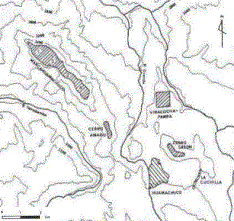« Arqueología »
OTHER HUARI CONSTRUCTIONS IN HUAMACHUCO

In Huamachuco, three other major complexes were probably constructed by the Huari: La Cuchilla, a major earthwork; a set of storerooms at Cerro Amaru; and a possible mausoleum at Marca Huamachuco.
The people of Huamachuco believe that La Cuchilla (Fig. 1) served as the aqueduct for Viracochapampa. McCown (1945: 260) felt that the earthwork might have been either a dam to prevent flooding of the pampa on which the modern town of Huamachuco is located or a causeway to cross the swampy pampa. Our initial opinion (Topic and Topic n.d.a: 17) was that the earthwork was an aqueduct but that it did not relate to Viracochapampa. This opinion was based on the observation that a canal crossing the aqueduct would have its intake almost 200 m higher and trace a course about 5 km longer than absolutely necessary to supply Viracochapampa. More recently, we began to consider the possibility of a pressurized water system. Such a system would fit with the high location of La Cuchilla and the selective use of kaolin clay in the canal openings at Viracochapampa. With this in mind we began to trace the line of the canal south of Viracochapampa, and its trajectory fits with the course of a canal crossing La Cuchilla. As already mentioned, this canal was never completed.
The earthwork is about 800 m long and has an S-shaped curve in it. The cop of the earthwork maintains an approximately level course across the pampa, in spite of the fact that the pampa is a very shallow depression. La Cuchilla has recently suffered much destruction by bulldozers, but McCown (1945: 259) reports a maximum width at its base of 15 m and a maximum height of 6-10 m. These maxima are reached near the middle of the aqueduct, and there is a gradual taper to both ends. Bulldozer cuts reveal that the mound was constructed of a mixture of rock and earth, with the rock often laid up as crude retaining or cribbing walls for the earth fill. The only similar Huari construction of which I am aware is the Rumiqolqa wall near Pikillacta: McEwan (this volume) points out that the Rumiqolqa is located below Pikillacta and could not have supplied that site with water.
The second complex of probable Huari architecture occurs at Cerro Amaru and consists of a series of round storerooms. We (Topic and Topic 1984: 45-50) have already described the storerooms and the site generally. Figure 6 serves to illustrate what the storerooms might have looked like. An important feature of these storerooms is the presence of raised floors with ventilation below, which we hypothesized would allow storage of seed crops. This hypothesis was confirmed recently by phytolith analysis (Chiswell n.d.: 111-113), which showed the presence of maize. The phytolith analysis also suggests that the roof was thatched with ichu grass. There may have been as many as twenty-four storerooms, but no more than seven or eight now remain. Associated with the round store-rooms were also at least two rectangular structures of unknown function. Since we have no local precedents for small separated round storerooms in Huamachuco, we tentatively consider these to be of Huari affiliation. The most similar structures are two Huari storerooms at Jargampata (Isbell 1977: 35-42), the rooms in the central sector at Azangaro (Anders, this volume), and some Incaic storerooms from Huamachuco (Topic and Topic 1984: 60-61). All these structures might have had raised floors, although they are also all rectangular rather than round.
After a period of use, the storerooms at Cerro Amaru were burnt. The architectural shells were then remodeled into what were probably domestic units. Two charcoal samples were dated (A.D. 400 ± 60 and A.D. 680 ± 80). The first sample probably derives from burned construction material from the original structure, while the second date probably relates to the reoccupation.
The third complex is a possible mausoleum (Fig.7). It is located on Cerro de los Corrales, one of the lees densely occupied areas of Marca Huamachuco. It is heavily looted, and because of this we have not yet tried to excavate the structure. The height of the mound or mausoleum is approximately 2 m (McCown 1945: 248), and holes dug in the ends show that there were interior chambers. The mausoleum is set within a square enclosure, about 60 m on a side, which contains several rooms and courts. The only. reason we feel this complex might have a Huari affiliation is that the masonry style is more similar to Viracochapampa than to Marca Huamachuco. It appears that this complex had been built over the ruins of an earlier circular gallery.
A rather similar mausoleum that we excavated at Cerro Amaru produced imported Huari pottery as well as other foreign styles (Topic and Topic 1984). That mausoleum, however, was constructed in the Huamachuco masonry style. A series of dates on wood charcoal probably all relate to the original construction of the mausoleum (A.D. 330 ± 105, A.D. 380 ± 65, A.D. 405±75A.D. 590± 65). The ceramics found in the mausoleum postdate the construction but predate the burning of the structure.
 Retornar
Avanzar
Retornar
Avanzar